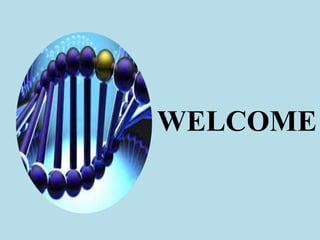
Karyotype analysis and it's evolution
- 1. WELCOME
- 2. Karyotype analysis and Evolution of Karyotypes
- 3. Karyotype Definition A karyotype is the number and appearance of chromosomes in the nucleus of a eukaryotic cell. The term is also used for the complete set of chromosomes in a species or in an individual organism and for a test that detects this complement or measures the number . The study of karyotypes is important for cell biology and genetics, and the results may be used in evolutionary biology and medicine.
- 4. History of karyotype Chromosomes were first observed in plant cells by Carl Wilhelm von Nageli in 1842. The name was coined by another German anatomist, Heinrich von Waldeyer in 1888. It is New Latin from Ancient Greek karyon, "kernel", "seed", or "nucleus", and typos, "general form"). Lev Delaunay seems to have been the first person to define the karyotype as the phenotypic appearance of the somatic chromosomes, in contrast to their genic contents (1922).
- 5. Observations on karyotypes Staining The study of karyotypes is made possible by staining. Usually, a suitable dye, such as Giemsa, is applied after cells have been arrested during cell division by a solution of colchicine usually in metaphase or prometaphase when most condensed. For humans, white blood cells are used most frequently because they are easily induced to divide and grow in tissue culture.
- 6. Observations Six different characteristics of karyotypes are usually observed and compared: I. Differences in absolute sizes of chromosomes. Chromosomes can vary in absolute size by as much as twenty-fold between genera of the same family II. Differences in the position of centromeres. These differences probably came about through translocations. III. Differences in relative size of chromosomes. These differences probably arose from segmental interchange of unequal lengths. IV. Differences in basic number of chromosomes. V. Differences in number and position of satellites. Satellites are small bodies attached to a chromosome by a thin thread. VI. Differences in degree and distribution of heterochromatic regions. Heterochromatin stains darker than euchromatin.
- 7. Variation is often found: I. between the sexes, II. between the germ-line and soma (between gametes and the rest of the body), III. between members of a population (chromosome polymorphism), IV. in geographic specialization, and V. in mosaics or otherwise abnormal individuals.
- 8. Diversity and evolution of karyotypes Although the replication and transcription of DNA is highly standardized in eukaryotes, the same cannot be said for their karyotypes, which are highly variable. There is variation between species in chromosome number. This variation provides the basis for a range of studies in evolutionary cytology.
- 9. Changes during development Chromosome elimination. In some species, as in many sciarid flies, entire chromosomes are eliminated during development. Chromatin diminution (founding father: Theodor Boveri). In this process, found in some copepods and roundworms. X-inactivation. The inactivation of one X chromosome takes place during the early development of mammals.
- 10. Number of chromosomes in a set The number of chromosomes in the karyotype between (relatively) unrelated species is hugely variable. The low record is held by the nematode Parascaris univalens, where the haploid n = 1; and an ant: Myrmecia pilosula . The high record would be somewhere amongst the ferns, with the adder's tongue fern Ophioglossum ahead with an average of 1262 chromosomes.
- 11. Ploidy Ploidy is the number of complete sets of chromosomes in a cell. Polyploidy, where there are more than two sets of homologous chromosomes in the cells, e.g.:3n, 4n etc. Haplo-diploidy, where one sex is diploid, and the other haploid. It is a common arrangement in the Hymenoptera, and in some other groups. Endopolyploidy occurs when in adult differentiated tissues the cells have ceased to divide by mitosis, but the nuclei contain more than the original somatic number of chromosomes.
- 12. Aneuploidy The number of chromosomes is not a multiple of the normal haploid number. Monosomy one member of a chromosome pair is missing, (2n-1) Trisomy one chromosome set consists of 3 copies of a chromosome, (2n+1)
- 13. Chromosome Banding Q (Quinarcine) G (Giemsa) N (NOR) C (Centromeric) 1958 1971 1973 1978 Casperson et.al Summer et.al Matsui & Sasaki Linde &Laursen
- 14. 1.Q Banding Techniques Chromosome Stained with Quinarcine Mustard Subjected UV light Banding Pattern Region rich in GC bases Region Rich in AT bases Light stainingDark staining GC region quenches dye but do not fluorescence ,situated in euchromatin region AT region quenches dye & fluorescence, situated in heterochromatin region
- 15. 2.G Banding Techniques Chromosome Weak Trypsin / urea/ protease Treated with Giemsa Banding pattern To denature protein Interaction of the DNA with thiazine & eosin components of stain brightens sulphur rich regions Methylene Azure+ Methylene Violet+ Methylene Blue+ Eosine
- 16. 3. N Banding Techniques Chromosome Air Dried Treated with 5% Trichloroacetic acid @ 95ᵒC for 30 min. Treated with 0.1N HCl @ 60ᵒC for 30 min. Banding pattern in Structural non- histone proteins linked to NOR region
- 17. 4. C Banding Techniques Chromosome Treating with alkali solution Washing with Sodium citrate @ 60ᵒC for 30 min. Staining with Giemsa Solution Banding pattern at heterochromatin region Repeatitive DNA renature but unique DNA do not renature DNA denaturing
- 18. Digital karyotyping Digital karyotyping is a technique used to quantify the DNA copy number on a genomic scale. Short sequences of DNA from specific loci all over the genome are isolated and enumerated. This method is also known as virtual karyotyping.
- 19. Chromosome abnormalities Numerical Extra chromosome missing chromosomes Structural Translocations Inversions Deletions Duplications
- 20. THANK YOU
